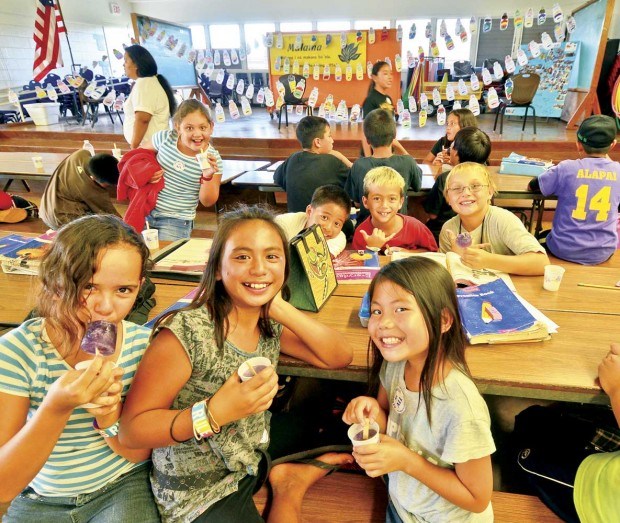LIHU‘E — They may be too young, but they know exactly what they want: an A+ treatment. People stopped to watch as a line of 240 A+ students at Elsie Wilcox Elementary School snaked around buildings and through the corridors
LIHU‘E — They may be too young, but they know exactly what they want: an A+ treatment.
People stopped to watch as a line of 240 A+ students at Elsie Wilcox Elementary School snaked around buildings and through the corridors Wednesday afternoon.
Chanting in support of the A+ program, the students wove their way from one end of the campus to the other, led by a student holding up the iconic hand-colored compact fluorescent lamp of the Lights on After-school event.
The Wilcox School A+ students, under the direction of Dr. Millie Johnston, were celebrating the achievements of after-school students and drawing attention to the need for more after-school programs to serve the millions of children across the nation who are unsupervised and at risk each weekday afternoon, states the After-school Alliance website.
“I think all of the A+ programs on the island received materials and an invitation to take part in this national program spearheaded by the After-school Alliance,” Johnston said. “But I don’t know how many of the other programs are participating.”
Johnston said the focus of the Wilcox School group was on exercise and healthy foods. The Kaua‘i High School Key Club volunteers joined the group in its cross-campus march to bring awareness to the after-school program and enjoyed a healthy snack of apples, carrots and grapes following the walk.
The Wilcox School A+ students join other programs from O‘ahu and one from Maui in hosting the Lights on Afterschool event. Last year more than 1 million Americans celebrated the event at more than 7,500 after-school programs. This is the 12th year the event has been celebrated.
In the state of Hawai‘i, 68,665 students, or 33 percent, of kindergarten through Grade 12 youth are responsible for taking care of themselves after school, states an After-school Alliance fact sheet on Hawai‘i.
Of all of the Hawai‘i students not currently enrolled in an after-school program, 28 percent, or 59,035 students, would be likely to participate if an after-school program was available in their community.
Hawai‘i has 39 percent, or 58,620 students, of the state’s K through 12 students participating in after-school programs, including 5,298 students in programs supported by the U.S. Department of Education’s 21st Century Community Learning Centers initiative, the only federal program dedicated to after-school.
The 21st Century Community Learning Centers initiative was reauthorized under the No Child Left Behind Act in 2002, transferring the administration of the grants from the U.S. Department of Education to the state education agencies.
Each state receives funds based on its share of Title I funding for low-income students and grants support after-school programs which provide academic enrichment activities which can help students meet state and local achievement standards; an array of services designed to reinforce and complement the regular academic program such as drug and violence prevention, counseling, art, music, recreation, technology and character education programs.
U.S. Sen. Daniel Akaka, D-Hawai‘i, joined other members of Congress to establish the After-school Caucus on March 3, 2005, in the Senate and in the House of Representatives, to build support for after-school programs and increase resources for quality after-school care.
“Work remains to be done toward placing new and qualified teachers in our schools, repairing and replacing crumbling facilities and providing affordable, quality child care and after-school opportunities,” Akaka said on the After-school Alliance website.
Hawai‘i’s After-School Plus, or A+, program was established in 1990 by the Hawai‘i Department of Education and provides after-school care including homework assistance and supervised recreational activities until 5:30 p.m. each school day at more than 190 participating schools.
The program is supported by $6 million in state general funds, and the current agreement provides for a payment of $85 a month for each eligible child, states the After-school Alliance. Elementary school-aged children whose parents work, attend school, or are in job-training programs are eligible to participate.
Visit www.doe.k12.hi.us and www.after-schoolalliance.org for more information.


